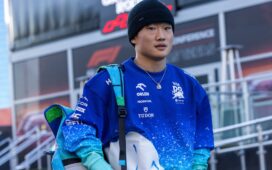TOKYO — As Christine Mboma of Namibia moved up from fifth place toward a silver medal in the homestretch of the women’s Olympic 200 meters on Tuesday, she began screaming in what appeared to be a mix of exertion and elation.
Just 18, Mboma finished second to Elaine Thompson-Herah of Jamaica in 21.81 seconds, the fastest time ever run by a woman under 20 years old.
She called her performance “the best race” of her young life. Yet Mboma was precluded from competing in Tokyo in what is perhaps her best event, the 400 meters, because of restrictions governing women with a rare genetic condition that results in naturally elevated testosterone levels.
Her stirring performance in the 200 meters reignited a complicated debate — and no doubt added to some public confusion — about who should be allowed to compete in certain women’s running events.
And while World Athletics, the sport’s global governing body, defended its rules, critics said that Tuesday’s 200-meter race raised questions about the scientific precision and validity of restrictions placed on athlete eligibility in women’s races from 400 meters to the mile.
Mboma and her Namibian teammate Beatrice Masilingi, who finished sixth in the 200 meters, have run three of the four fastest times in the world this year at 400 meters. Last month, though, they were declared ineligible for the 400 at the Olympics by World Athletics. On Monday, Masilingi called the ruling “very cruel.”
Namibia’s Olympic committee said in a statement in July that Mboma and Masilingi had naturally high levels of testosterone and were unaware of it until they underwent a medical assessment at a training camp in Italy. The two sprinters were declared ineligible for the 400 meters, according to rules pertaining to athletes with so-called disorders of sexual development, or DSDs, the Namibian committee said.
World Athletics rules require that affected athletes who want to compete in women’s running events from 400 meters to the mile — events that require a combination of speed and endurance — must first reduce their elevated testosterone levels below the normal male range.
Mboma and Masilingi qualified for and entered the Olympic 200 meters, which is not governed by the testosterone restrictions.
The World Athletics rules do not restrict athletes who simply have naturally high testosterone levels. They govern intersex athletes with a disorder of sexual development known as 46, XY DSD. These athletes have an X and Y chromosome in each cell, the typical male pattern; genitalia that are not typically male or female; and testosterone in the male range, which, doctors say, suggests testicular tissue or internal testes.
Mboma’s silver medal raised a question: Does the supposed significant physiological advantage gained by intersex athletes end at 399 meters? Or is the science relied on by World Athletics to institute its restrictions flawed and in need of re-evaluation or expansion to include other running events?
“It shows this is not an evidence-based regulation,” said Roger Pielke Jr., a professor of environmental studies at the University of Colorado who has long questioned the scientific basis of the restrictions. “It’s about World Athletics’s perception as to who is properly a woman and who is not.”
Jackie Brock-Doyle, the director of communications for World Athletics, defended the governing body’s rules. Ten years’ worth of evidence indicates that significant performance advantages for athletes with disordered sexual development exist from 400 meters to the mile, not in shorter or longer events, she said.
“We feel we’ve got this right,” Brock-Doyle said.
Proponents of the restrictions have frequently noted that all three medalists in the 800 meters at the 2016 Olympics in Rio de Janeiro, led by the gold medalist Caster Semenya of South Africa, were athletes with disorders of sexual development. Not so with the women’s 200 meters in Tokyo, where Thompson-Herah, the victor in 21.53 seconds, became the first woman to win the 100 and 200 meters in consecutive Olympics.
Tuesday’s outcome, Brock-Doyle said, demonstrated that “we want to be inclusive and we want to find ways for people to compete, no matter who they are.”
Brock-Doyle said World Athletics would review its regulations “if we see significant advances in anything that looks as if the playing field is no longer fair.”
World Athletics acknowledges that its restrictions, implemented in 2018, are discriminatory, but argues that they are “fair, necessary and proportionate” for female athletes to be able to participate on a level playing field in terms of strength, muscle mass and oxygen-carrying capacity.
Critics have argued that it has not been precisely determined how much of an advantage elevated testosterone levels provide; that treating athletes to lower testosterone levels is unnecessary and can have side effects; and that the restrictions disproportionately affect athletes from developing nations. The World Medical Association has said that the restrictions are based on “weak evidence” and has urged doctors not to help enforce them.
Gabby Thomas of the United States, the bronze medalist in Tuesday’s 200-meter final, was asked about the regulations and the presence of Mboma and Masilingi in the race.
“It’s hard to have an opinion on that when I don’t actually know their biology,” said Thomas, who majored in neurobiology and global health at Harvard. “I don’t know how decisions are being made. So I do my best to stay out of it.”
Noting that she had won a medal, Thomas added, “I’m happy with that.”
Mboma declined to comment about being barred from the 400 meters, saying: “I just keep my head down and concentrate on the 200 meters. Now, I got a medal. Happy.”
She was asked by reporters if she could have won gold in the 400. There was a long pause, and she appeared to nod. Mboma then said she believed she could have won a medal.
“I could have,” she said.
Jeré Longman reported from Philadelphia.






